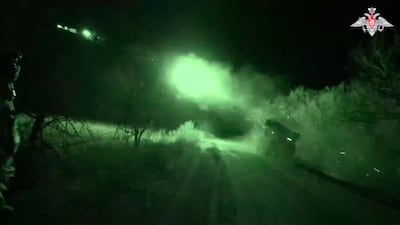Russia is preparing for a major offensive – with the potential for a breakthrough – on the Ukraine front line in the next month when the muddy terrain dries out, according to military analysts.
Ukraine’s military is in a race against time to build defences against the advance that could shatter their 1,000km front line.
There are growing concerns that Kyiv’s ammunition stockpile is dangerously low, without enough being provided by European powers while Republicans in the US block a $61 billion aid package in Congress.
The build-up
Sources on X have reported “intensified movement” of Russian military equipment and personnel in Luhansk province, eastern Ukraine.
Tanks, armoured personnel carriers, fuel bowsers and Ural lorries are reported to be massing.

The build-up of weapons and ammunition in “very significant quantities” points to “preparation for another attempt to change the line”, said military analyst Sam Cranny-Evans, of the Rusi think tank.
“The big difference now written large is that air defence and fire superiority have shifted in Russia's favour,” he added.
Breakthrough worries

Since November last year, following Ukraine’s summer offensive, Russian forces have taken an estimated 505 square kilometres of the country’s 603,000 square km total.
Even the mud season known as “rasputitsa” in Russian, or “season of bad roads”, has not stopped the Kremlin pushing forward infantry who have died in their thousands.
But once the mud dries the main effort is expected to begin with armour and artillery massing along the front line.
Russia has also adapted a mass fire tactic that includes the innovation of glide bombs, in which they have essentially put fins on a 750kg “dumb” bomb that is launched by aircraft from a distance but strikes with reasonable accuracy.
Ukrainian strong points in the city of Avdiivka became unsustainable once hit by a series of glide bombs, followed up by heavy artillery fire and frontal infantry assaults that took the city last month, albeit with claims of 17,000 Russian dead.

Numbers game
Without calling a general mobilisation, Russian President Vladimir Putin has been able to generate a steady flow of 300,000 soldiers a year, along with enough tanks and artillery rounds to last until 2025.
Mr Putin could also use the ISIS concert hall attack in Moscow, in which at least 140 people were killed, as an excuse for a nationwide call-up.
By contrast Ukraine is struggling to fill its ranks, with legislation on increasing conscription stalled by political bickering.
As the law stands no one under 27 can be called up, which was why Ukraine’s former military chief, Gen Valery Zaluzhny, called for a mobilisation of 500,000 troops.
“Mobilisation in Ukraine has become such a hot topic because they need enough personnel to respond to the Russian mass,” said Mr Cranny-Evans.

Vulnerable lines
Russia is likely to use its spring offensive to press forward at multiple points along the front line, ready to exploit any vulnerabilities.
“There is a chance that cumulative pressure could collapse part of the Ukrainian front line, exploited by a Russian breakthrough,” said retired Brig Ben Barry of the International Institute for Strategic Studies think tank.
In the opinion of Col Hamish de Bretton-Gordon, a former British army tank commander, the Kremlin would not hesitate for its troops to be “slaughtered in their thousands” to make a significant breach.
“They could make big inroads but take an absolute hammering, and I expect Putin would trade 50,000 deaths for a 100-mile intrusion into Ukraine,” he said.
Lacking artillery, the Ukrainians have resorted to using tens of thousands of quadcopter drones, each fitted with a rocket-propelled grenade warhead using FPV (first person view) to send them to target. These stocks are running low.
The Ukrainians are said to be shepherding their advanced western missiles to use against a Russian concentration such as the one reported in Luhansk.
“If the Russians concentrate and it turns out that the Ukrainians have saved quite a few salvos of HIMARS [high mobility artillery rocket system] missiles it might prevent the Russians concentrating again,” said Mr Cranny-Evans.
The problem is the pressure will be across the entire line, making it difficult to know where to stockpile arms, he added.

Do look up
The Russians also know that the opportunity to launch a successful offensive becomes more difficult by the week.
Despite the delays, the US Congress could pass a substantial military package early next month that might arrive just in time to re-arm the Ukrainians.
Every day that passes also means that Kyiv can strengthen the defences along the front line, planting more mines and tank traps while digging deeper strongholds.
By June the first squadron of US-made F-16 fighters will be commissioned into the Ukrainian air force, presenting a threat to Russia’s air dominance.
“When the Russians look up and see the F16s that are due in June that will be quite a significant moment,” said Col de Bretton-Gordon.

Western aid delayed
While the Russian economy is on a war footing, with military spending reaching a third of the national budget and equivalent to 7.5 per cent of GDP, the West’s response is lackadaisical.
The EU's promise of one million artillery rounds by spring has only achieved a third of that number, while Germany and France swither over sending missiles and money.
A Russian breakthrough might provide the incentive to propel arms production but, as the conflict has shown, retaking ground is much costlier than defending it.
“Europe needs to do more and faster,” said Brig Barry.
“If Europe is serious about helping Ukraine, it should divert all its 155mm artillery deliveries there immediately,” said Mr Cranny-Evans.
A failure in Ukraine would bring the likelihood of war between Nato and Russia much closer, the analysts agreed, making this spring another crucial period.
“The coming months are shaping up to be more critical to the direction of conflict than the 2024 stalemate scenario suggested,” said Brig Barry. “For now, the land war looks bloody and favours Moscow.”

